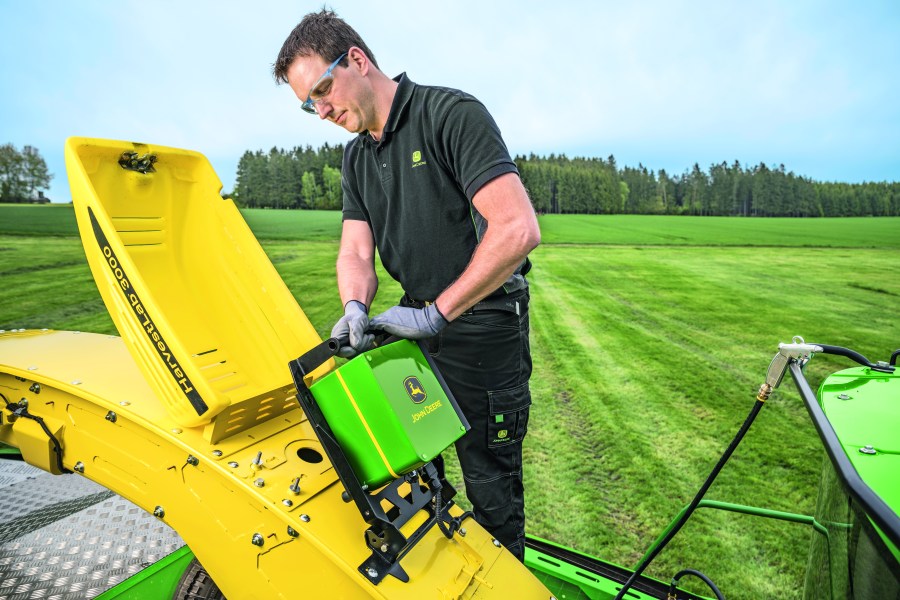Operating a contracting business in the Scottish Borders, David Wood and his brother Kenny have been using harvest monitoring technology on their foragers since 2016 to provide their customers with up-to-date and accurate information.
While R Wood and Sons offers a number of services from cultivations to drilling, baling and bale chasing, silaging is by far the most significant part of the operation. Covering all of the Scottish Borders, East Lothian and parts of Northumberland, the business runs three foragers which are used to cut grass silage and wholecrop.
“We cover around 4050ha of grass and 1010ha of wholecrop for dairy, beef and sheep farms as well as for an AD plant,” explains David.
David’s father Robert started the business in the mid-1980s, with chopping silage and wholecrop incorporated in 1996. “We started out using a modified combine header before moving to a dedicated wholecrop header in 2002 and a disc bed header in 2005. We now run three foragers, two of which have wholecrop headers.”
HarvestLab
All three machines are John Deere and include an 8400, an 8500 and a recently purchased wide bodied 9500. “All of the foragers have John Deere’s HarvestLab which is something we first invested in in 2016 when it was introduced on the then new 8000 range,” explains David.
“John Deere approached a number of its larger customers about the technology at the time and we decided to invest with the idea that it could potentially offer more to our customers. However, we started cautiously because we wanted to prove to ourselves and our customers that it worked before we offered it as part of our service.”
To test the accuracy of the technology in terms of tonnage of grass and dry matter, David would compare the HarvestLab data with that produced from some of his customers’ weigh bridges and their samples. “Once we’d been able to do this and the results matched up, we knew it was reliable.”
Customer requests
He now finds that if a customer hasn’t requested HarvestLab’s data by the time he’s left their farm, he’ll more than likely get a message requesting it the following day.
“In the past we’d get asked about how much diesel we’d use but the priority for most of our customers now is to know yield and dry matter content. However, there are other benefits to HarvestLab such as being able to quickly determine if a cut requires another pass with a tedder or comparing the wilting characteristics of one variety of grass against another using the yield monitor.”
Using the data collected by HarvestLab, David’s customers can far more accurately use additives in their silage based on yield mapping, he adds. “I’ve noticed that more of my dairy customers are trying to produce the best quality product, so the more data they have to be able to accurately apply additives, the better their silage.”
Chop length
The technology also has the ability to alter chop length depending on the dry matter content going through the forager, says David. “If the crop is drier, it’ll automatically shorten the length, and if it’s wetter, it’ll lengthen in to achieve a better consolidation in the clamp.”
Although HarvestLab comes at an additional cost to the base price of a forager, because the data is something his customers want, David has been able to include the cost of providing this extra service in his price per hectare.
“It’s difficult to quantify how it pays for itself, but it was only last year that I traded in the original machine I had HarvestLab on, so during the lifetime of that forager I’m sure it’s covered the initial investment.”
He’d originally hoped to be able to provide a further service of analysing silage that came out of the clamp, but because feed companies do this for free, there wasn’t a marketable opportunity.
Collaboration
More recently he’s been approached to work with someone who’s using historical data to build an AI which will calculate feed rations. “All of our data is stored in Operations Center and this goes back to when we started with Harvest Lab in 2016, so we have plenty of information.”
He also values the communication between Operations Center and his machines, which automatically transfers field boundaries and identifies where a machine is. “I can send an operator out at the start of the season, the system recognises where they are and uploads the data – it’s very user-friendly.”
Other than one hardware issue in 2019 whereby one of the lenses in the technology was moving, HarvestLab has consistently performed. To pinpoint the issue at the time, David ran both foragers side-by- side and could determine that the dry matter and sugar readings were coming through inaccurately.
One feature David would like to see in future is the ability for the technology to read the constituents of wholecrop. “We can read the constituents for maize and grass but not wholecrop yet,” he concludes.
This story is part of a larger feature on using monitoring technology on foragers at harvest.




